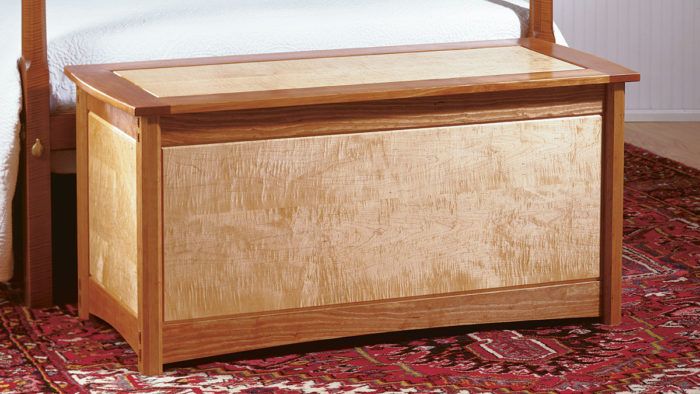A Blanket Chest with Legs
Simple frame-and-panel construction lets you break out of the boring box
Synopsis: Instead of dovetails, John McAlevey used frame-and-panel construction on the blanket chest he designed and built in curly maple and cherry. The legs serve as the stiles of the frame-and-panel sides, so they are mortised for the rail tenons as well as grooved for the panel tongues. Detailed project drawings show a straightforward layout and the interesting shadow lines of the design. McAlevey explains how preparation pays dividends during mortising and how he used a cove bit to shape the panels. He says assembly is easy and tells how to do it in sections.
I have always liked designing and making sideboards, chests of drawers and blanket chests. It is very satisfying to make a basic box that will contain and store the things that we use in our everyday lives. And when it works, the result can be as beautiful as it is useful. It’s even more satisfying when you can transform a basic box into something with depth, dimension and visual power.
The blanket chest I designed and made for a family in New Hampshire is a piece of furniture that could have been just another unremarkable dovetailed box, but it is redeemed by frame-and-panel construction that allows for greater play with forms and materials. It pleases me to think that many years from now, someone will open this chest on a snowy December night, pull out a down comforter as proof against the cold, and think, “What a beautiful chest.”
A chest made of four solid slabs dovetailed together looks too heavy and traditional for my taste, and I can assemble frames and panels much more quickly than I can cut long rows of dovetails. Frame-and-panel construction has more going for it than lightness and economy of labor: It adds depth and shadow lines to the look of a piece, and it allows the use of contrasting wood—something you can’t do with mitered or dovetailed chests made only from flat panels.
My client wanted a fresh design that incorporated elements of two of my previous frame-and-panel chests. In a departure from one of the older designs, I decided to eliminate the stiles of the frame-and-panel sides and join the top and bottom rails directly to the legs so that the legs themselves serve as stiles. This legs-as-stiles approach, which I had first tried nine years ago on a cabinet, allows for simplified construction and a lighter look than full frame-and-panel sides attached to separate legs. (Squinting at the blanket chest, you can almost imagine away the light-colored panels, leaving behind an open frame of thin, tablelike legs and rails.) A gentle curve in the bottom rail helps the legs visually lift the chest off the floor.
From Fine Woodworking #129
For the full article, download the PDF below.
Fine Woodworking Recommended Products

Festool DF 500 Q-Set Domino Joiner

Dubuque Clamp Works Bar Clamps - 4 pack

Starrett 12-in. combination square






















Log in or create an account to post a comment.
Sign up Log in